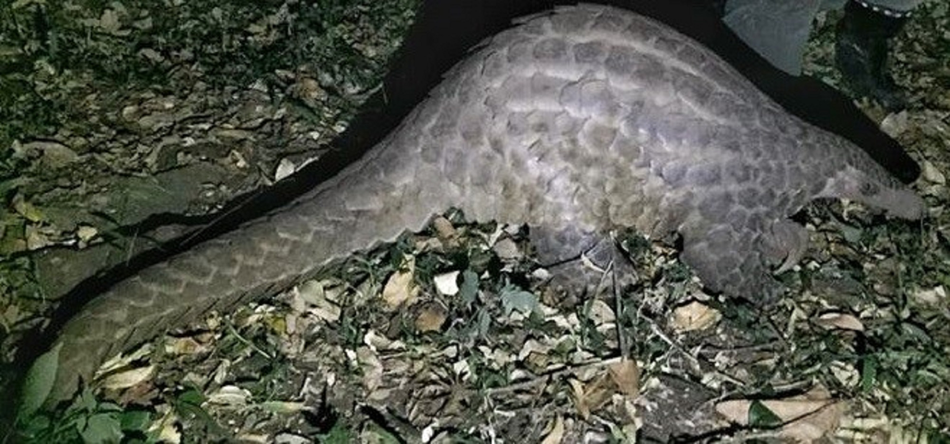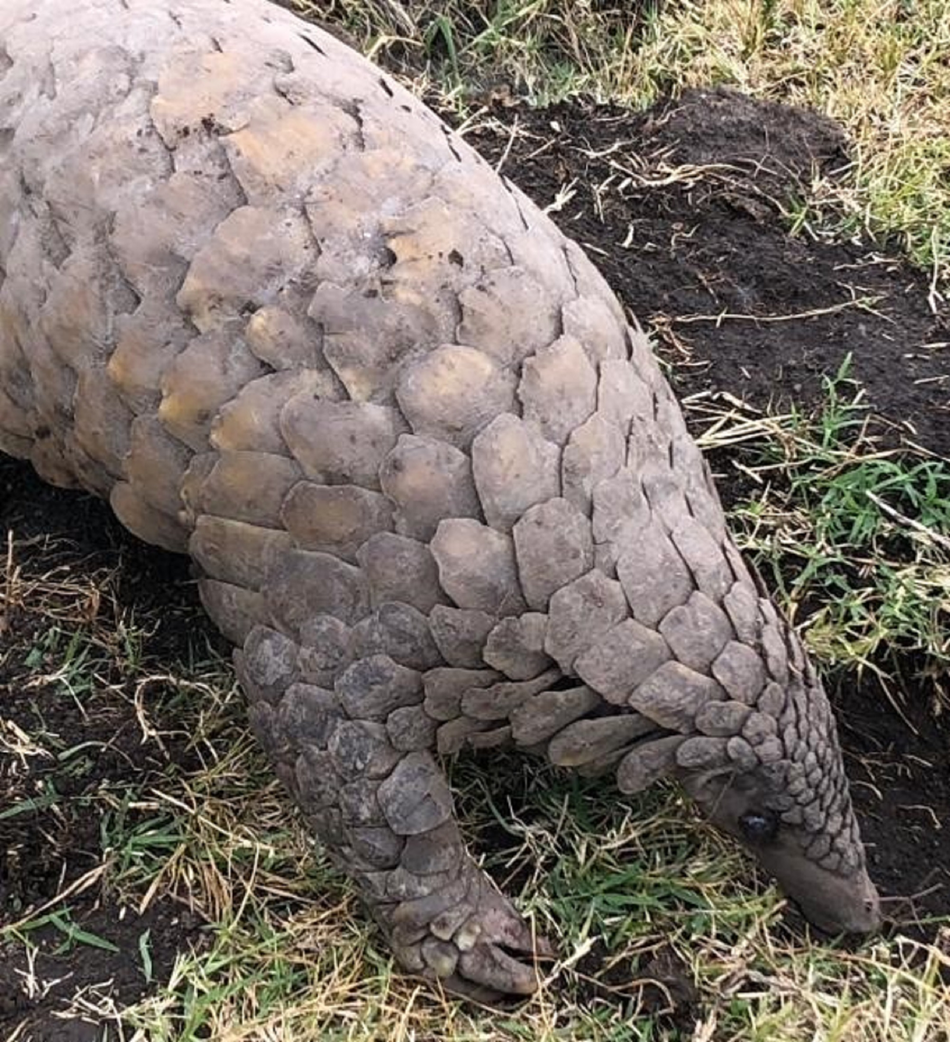Pangolins (family: Manidae) are amongst the most trafficked wild mammals, and illegal trade in their scales, predominantly for international markets, is a recognized threat (Nixon et al., Reference Nixon, Pietersen, Challender, Hoffmann, Godwill Ichu and Bruce2019). All eight pangolin species are categorized as threatened on the IUCN Red List, with the four Asian species categorized as either Critically Endangered or Endangered, and the four African species (Temminck's pangolin Smutsia temminckii, giant pangolin Smutsia gigantea, black-bellied pangolin Phataginus tetradactyla and white-bellied pangolins Phataginus tricuspis) categorized as either Vulnerable or Endangered (IUCN, 2021). Pangolins are traditionally hunted for their meat and other body parts. Overexploitation of the Asian pangolin species, consistent demand for pangolin derivatives in East Asia and improved trade links between Africa and international markets have intensified the trafficking of African pangolin scales (Ingram et al., Reference Ingram, Coad, Abernethy, Maisels, Stokes and Bobo2018).
Despite their conservation status, pangolins are amongst the least studied mammalian groups (Ingram et al., Reference Ingram, Willcox and Challender2019). Apart from the black-bellied pangolin, these solitary animals are predominantly nocturnal, seem to occur at low densities and are challenging to study (Willcox et al., Reference Willcox, Nash, Trageser, Kim, Hywood and Connelly2019). For most of the African pangolin species, a paucity of information on distribution, abundance and ecology makes it difficult to monitor populations and quantify the impact of exploitation.
The giant pangolin is the largest extant pangolin species, measuring up to 180 cm in total length and weighing up to 40 kg (Kingdon et al., Reference Kingdon, Hoffmann, Hoyt, Kingdon and Hoffman2013). It is nocturnal, terrestrial and solitary and is distributed widely across the rainforests and forest savannah mosaics of equatorial Africa (Hoffmann et al., Reference Hoffmann, Nixon, Alempijevic, Ayebare, Bruce, Davenport, Challender, Nash and Waterman2020). In West Africa the species has been confirmed from Senegal to Ghana, with its distribution in Burkina Faso, Togo and Niger uncertain; the species was recently confirmed at a single site in south-eastern Nigeria (Hoffmann et al., Reference Hoffmann, Nixon, Alempijevic, Ayebare, Bruce, Davenport, Challender, Nash and Waterman2020). In Central Africa the confirmed giant pangolin distribution stretches from Cameroon through the Congo Basin, to Uganda in East Africa. The species has recently been recorded in western Tanzania and South Sudan (Hoffmann et al., Reference Hoffmann, Nixon, Alempijevic, Ayebare, Bruce, Davenport, Challender, Nash and Waterman2020). A single observation predating 1971 on the shores of Lake Victoria near the Ugandan border was formerly the only record of this species in Kenya (Kingdon, Reference Kingdon1971).
Here we present three spatially separate photographic records confirming the presence of the giant pangolin in western Kenya. Given the conservation status of this species and the threat posed by illegal offtake, we provide only approximate locations of the records (Fig. 1). The first is the result of a camera-trap survey conducted in July 2018 in a primary highland forest in Kenya's Rift Valley region, in which a giant pangolin was captured in a single event (Plate 1). The presence of the giant pangolin in this location potentially makes it sympatric with Temminck's pangolin, a species with which the giant pangolin can be confused because of their morphological similarities (Hoffmann et al., Reference Hoffmann, Nixon, Alempijevic, Ayebare, Bruce, Davenport, Challender, Nash and Waterman2020). Although the area where the image was captured is within the defined range of Temminck's pangolin (Pietersen et al., Reference Pietersen, Jansen and Connelly2019), to our knowledge there are no confirmed records of Temminck's pangolin from this area nor from rainforest habitats anywhere across its range. Confirmation of this record being a giant pangolin is based upon the habitat type and several physical characteristics: Temminck's pangolin is considerably smaller than the giant pangolin (up to 140 cm in total length and weighs up to 21 kg; Pietersen et al., Reference Pietersen, Jansen and Connelly2019), and a blue duiker Philantomba monticola captured in the same position on the same camera (head and body length 55–90 cm and shoulder height 32–41 cm; Kingdon et al., Reference Kingdon, Hoffmann, Hoyt, Kingdon and Hoffman2013) provided a size reference. The pangolin recorded here is estimated to be at least 140 cm in length, with the girth, tail length, elongated head and body shape indicative of a giant pangolin. The front legs are relatively long and robust, suggesting the quadrupedal locomotion characteristic of the giant pangolin rather than the bipedal locomotion of Temminck's pangolin, and the scale shape and rows are more consistent with those of the giant pangolin, having a greater number of more rounded scales relative to overall size (Hoffmann et al., Reference Hoffmann, Nixon, Alempijevic, Ayebare, Bruce, Davenport, Challender, Nash and Waterman2020).

Fig. 1 Range of the giant pangolin Smutsia gigantea, showing its eastern extent in relation to west Kenyan Afromontane forests (Nixon et al., Reference Nixon, Pietersen, Challender, Hoffmann, Godwill Ichu and Bruce2019) and the approximate locations of the new records.

Plate 1 Giant pangolin Smutsia gigantea photo-trapped in an Afromontane forest in western Kenya, on 19 July 2018 at 22.28. Photo: T. Sandri.
This sighting was c. 500 km east of the nearest confirmed population of giant pangolins in Ziwa Rhino Sanctuary in Uganda and c. 200 km east of the single previous Kenyan record (Kingdon, Reference Kingdon1971), making this sighting the easternmost record of a giant pangolin. Furthermore, at an altitude of 2,466 m this is the highest confirmed record for the species (Hoffmann et al., Reference Hoffmann, Nixon, Alempijevic, Ayebare, Bruce, Davenport, Challender, Nash and Waterman2020). Although located c. 10 km from the nearest human settlement on the edge of the forest and c. 35 km from the nearest conurbation, there was substantial evidence of logging within the boundaries of the relatively small camera-trap grid (12 cameras 1 km apart) suggesting a degree of anthropogenic presence at this site.
The second record, also from 2018, was c. 120 km south of the first record: a safari guide travelling at night saw a pangolin, at the time believed to be a Temminck's pangolin, ambulating by the side of the road (Plate 2). The photograph was posted on social media and was noticed by members of a local NGO, The Pangolin Project. The individual was identified as a giant pangolin based upon the physical characteristics of its elongated head, its relatively long tail compared to that of a Temminck's pangolin and comparison with images of both species.

Plate 2 Giant pangolin photographed by the side of the road on the edge of the savannah–Afromontane belt in western Kenya, in July 2018. Photo: S. Dyson.
A third record was reported in August 2018, c. 4 km west of the second sighting. A pangolin that had become trapped under an electrified fence was removed and relocated to a nearby forest. Videos and photographs were used to identify the animal based on its size, relative tail length, forelimb definition and movement suggesting the animal to be quadrupedal (Plate 3). Both the second and third records were located on the edge of the savannah–Afromontane forest belt at altitudes of 1,900 and 2,000 m, respectively.

Plate 3 Giant pangolin photographed during release after becoming trapped under an electrified fence. Photo was taken on the edge of the savannah–Afromontane belt in western Kenya, in August 2018. Photo: T. Davis.
These three records confirm the presence of the giant pangolin within the Afromontane forests of Kenya and represent a significant range extension for the species. The Eastern Afromontane region of Africa is characterized by high levels of endemism and significant anthropogenic pressure (Brooks et al., Reference Brooks, Hoffmann, Burgess, Plumptre, Williams, Gereau, Mittermeier, Gil, Hoffman, Pilgrim, Brooks and Mittermeier2004). The high levels of endemism and species richness are presumed to be the result of long-term isolation and environmental stability (Demos et al., Reference Demos, Peterhans, Agwanda and Hickerson2014). As a function of historical connectivity, the Kenyan Afromontane forest remnants support species with contiguous distributions in Central and West African forests. The occurrence of giant pangolins in the highland forests of Kenya is consistent with the forest refugia model confirmed for other forest species in Kenya (Kadu et al., Reference Kadu, Schueler, Konrad, Muluvi, Eyog-Matig and Muchugi2011).
Anthropogenic pressure on the wetter highland areas of Kenya is intense as these areas have the greatest level of agricultural productivity, are sources of timber, charcoal and wild meat and provide most of the surface water for the country (Morrison et al., Reference Morrison, Higginbottom, Symeonakis, Jones, Omengo, Walker and Cain2018). The giant pangolin has a low reproductive rate and is particularly sensitive to overexploitation, usually only persisting in areas where hunting pressure is low (Kingdon et al., Reference Kingdon, Hoffmann, Hoyt, Kingdon and Hoffman2013; Bruce et al., Reference Bruce, Kamta, Tabue Mbobda, Talla Kanto, Djibrilla and Moses2018).
The presence of this Critically Endangered species in the Afromontane forests of Kenya highlights the conservation priority of these areas. Further research is needed to confirm the range and population status of the species in Kenya, especially considering there are several forest complexes in the country that have not yet been surveyed in detail for fauna.
Acknowledgements
We thank S. Dyson and T. Davis for supplying the images for Plates 2 and 3, respectively, and the Kenya Wildlife Service for permission to conduct the camera-trap survey and publish the findings. TS was funded by Chester Zoo and the survey was conducted under permit NACOSTI/P/18/16140/21823 from the National Council for Science and Technology of the Republic of Kenya.
Author contributions
Fieldwork: TS, CO, FO, JM, SN, BC; photographs: TS, CO; identification: NM, SN, DWSC; writing: CO, TS, BC; revision: all authors.
Conflicts of interest
None.
Ethical standards
The photographic records were obtained non-invasively and this research otherwise abided by the Oryx guidelines on ethical standards.






